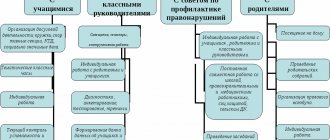Everyone has had to break the rules at least once in their life. Some people are used to throwing candy wrappers on the ground and not in the trash can. Someone hangs out 24 hours a day in computer games, not communicating with anyone, not working, not getting enough sleep and not really eating. And some people drive themselves to exhaustion with various diets.
Few people know that all these actions fall under deviant behavior - deviations from the norm. Most people believe that it is characteristic only of drug addicts, alcoholics, criminals and other antisocial elements of society. Psychologists are more unforgiving: according to their statistics, 90% of people (from time to time or constantly) are deviants.
Basic Concepts
In simple words, deviant behavior is persistent (constantly repeated) behavior that deviates from generally accepted social norms. There is another concept for this phenomenon - social deviation. Society is forced to respond to it with certain sanctions: isolation, treatment, correction, punishment.
Since deviant behavior is the subject of study of various sciences, each of them gives it its own specific definition.
Sociology
Sociologists call deviant behavior any social phenomenon that poses a threat to human life, caused by a violation of the process of assimilation of norms and values, self-development and self-realization in society.
Medicine
For doctors, deviance is a borderline neuropsychic pathology that leads to deviation from generally accepted norms of interpersonal interactions. At the same time, doctors recognize that not all cases are the result of personality and behavioral disorders. Mentally healthy people often demonstrate deviant behavior.
Psychology
In psychology, this is a deviation from social and moral norms, an erroneous conflict resolution pattern directed against society. It can be measured quantitatively (which determines the degree of neglect of the problem) - through the damage caused to public well-being, others or oneself.
Based on these definitions, it is not difficult to understand who a deviant is. This is a person who demonstrates traits of deviant, unacceptable behavior and needs the help of specialists: psychologists, psychotherapists, neurologists.
The psychology of deviant behavior is a scientific discipline that studies the essence, causes and manifestations of persistent inappropriate behavior. Various specialists work in this area - clinical and developmental psychologists, teachers, lawyers and sociologists. Currently, special attention is paid to methods of prevention and correction of deviations in adolescence and youth.
Deviantology is a science that studies deviations and society's reaction to them. It includes work in this direction, carried out by various sciences: psychology, psychotherapy, criminology, sociology.
Types of deviant behavior
Socially approved - have a positive impact, directing society to overcome outdated norms of behavior and values that contribute to a qualitative change in the structure of the social system (genius, creativity, achievements, etc.).
Neutral – not bearing noticeable changes (clothing style, eccentricity, unusual behavior).
Socially disapproved – changes that bring negative consequences to the social system, resulting in dysfunction; destruction of the system, provoking deviant behavior that harms society; delinquent behavior; personality destruction (alcoholism, drug addiction, etc.).
Existing problems
The problem with deviation is that many do not understand its scale. Who among us has not at least once done something that would be condemned by society? Psychologists say that every person has his own “skeletons in the closet,” but they are carefully guarded from prying eyes in order to avoid condemnation. The only question is how dangerous they are. Someone regularly steals strawberries from a neighbor's summer cottage, or smokes in the entrance, or plays music at full volume after 11 p.m. in an apartment building. And someone beats his wife, steals millions from public accounts, distributes drugs. All these are examples from life, but feel for yourself how different they are in their consequences.
The second problem of society associated with deviants is asymmetrical control over them. We often hear about famous people violating social and moral norms. But they usually go unpunished. Although when a simple person commits the same act, the matter is not limited to just condemnation.
Origin of name. The term "deviant" comes from the Latin word "deviatio", which translates as "deviation".
What is deviant behavior
Under deviant behavior
It is common to understand actions that contradict established social norms.
The persistent manifestation of deviations forces society to apply sanctions to this person - isolation, punishment, correction, treatment.
Simply put, deviation is a violation of any rules. In this regard, psychologists claim that the vast majority of people on the planet are deviants. Indeed, it is difficult to live your whole life without violating a single established rule - this means not only state legislation, but also some informal regulations, such as the need to communicate with friends in your free time. Too much work ethic (“workaholism”) and a passion for dieting are also deviations.
Causes
Biological
Hereditary, genetically determined tendency to deviant behavior, manifested from a young age. Such problem children can be seen even in kindergarten. At school, deviations worsen and provoke the development of mental personality disorders.
Psychological
Sometimes a person from birth has a rebellious character that makes him go against the system. External factors and stimuli are also causes of deviation. The maladaptive development of the psyche due to certain character traits (aggressiveness, low self-esteem, helplessness) may be to blame. Psychologists often explain deviations by a psycho-emotional state that is stable over a long period of time (for example, with depression or the loss of a loved one).
Sociological
The socially determined causes of deviant behavior are well described and explained by the theory of anomie, created by the French sociologist and philosopher David Durkheim. According to his definition, anomie is the decomposition of established social values and norms due to inconsistency with new ideals. This is a kind of vacuum that provokes people to deviate. It is always accompanied by a sharp increase in the number of alcoholics, drug addicts, suicides, and criminals.
Pathogenesis
The course of deviant behavior in adolescents is quite complex. Deviations develop due to a violation of the child’s orientation in the system of social values, norms and rules.
If during the age crisis, when the needs of self-determination and self-expression are heightened, there is no stable system of values, high-quality social conditions and support from a close circle of people, then the teenager develops pathologies of behavioral deviations. During this period, illegal and immoral actions are dictated by the desire to attract attention, to prove one’s strength, independence and significance, and independence.
Theories
Based on the leading causes of deviations from social norms, various theories of deviant behavior have been created.
Biological theories
The bottom line: deviant actions are a consequence of innate inclinations. Such people cannot restrain their base needs and do everything to satisfy them, regardless of the rules and even the fear of punishment.
Lombroso
The theory of the innate criminal of the Italian psychiatrist, teacher and psychologist Cesare Lombroso is biological. Based on the results of many years of work in prisons, the scientist concluded that the deviant actions of 1/3 of all criminals are due to qualities inherent in nature itself. They all differ in a set of the same characteristics:
- stubborn in their malice and ferocity;
- underdeveloped;
- unable to curb their instincts;
- not amenable to correction;
- having a specific appearance: a disordered jaw, a flat nose pressed into the face, a sparse beard, long arms.
Lombroso compared them to monkeys. But the British doctor Charles Goring criticized his theory and substantiated its inconsistency.
Sheldon
The constitutional theory of temperament of the American psychologist William Herbert Sheldon also belongs to the biological ones. In his opinion, a person’s actions can be predicted by his body type:
- endomorphs (moderately overweight) are sociable and know how to get along with others;
- mesomorphs (strength and slimness) are restless, active, insensitive to pain and most prone to deviant behavior;
- ectomorphs (fragile body) are prone to introspection, have increased sensitivity and nervousness.
However, Sheldon's theory doesn't always work. Among criminals and other persons with deviant behavior there are people with different body types.
Gove
Another biological theory based on the influence of gender and age characteristics. Author: Walter Gove. Conclusions from the research:
- Most often, deviant actions are observed among young people, the peak occurs at 18-24 years old;
- in second place are teenagers 13-17 years old;
- on the third - 25-30 years;
- and only then comes the age after 30 years, when crimes are committed either in a state of passion or as a result of serious mental disorders.
There is also scattered evidence from individual studies suggesting that the tendency to deviate may be due to genetics:
- twins with the same number of chromosomes in 50% of cases commit the same violations of norms separately from each other, without agreement;
- Adopted children with their deviations are similar to biological, not adoptive parents;
- men with an additional chromosome Y are characterized by severe psychopathic behavior, low intelligence and increased deviation.
Most psychologists do not accept biological theories. The only thing they agree on is that the type of nervous system can play a certain role in deviant behavior, but it is far from decisive.
Social psychological theories
The bottom line: society itself provokes a person to violate its own rules.
Durkheim
Durkheim's famous theory of anomie. In his opinion, during crises, wars, revolutions, coups, changes in power and other social changes, people are in a state of confusion and disorganization and lose their bearings. This makes them behave inappropriately.
Merton
The theory of personality adaptation to the surrounding conditions of the American sociologist Robert Merton expands on Durkheim's anomie. According to it, deviation is influenced not only by social crises, but, first of all, by a person’s reaction to them. This classification is presented below.
Becker
One of the most famous social psychological theories is the theory of labels or stigma. The author is American economist Gary Stanley Becker. He described the process of labeling by the powerful sections of society - the lower ones. Traditionally, gypsies, homeless people, drug addicts, and alcoholics are classified as deviants. But this is unfair, because among them there may be people who adhere to general rules and do not break the law. However, the label of an antisocial, dysfunctional layer of society makes them ultimately behave like deviants.
Psychological theories
The bottom line: the main causes of deviant behavior lie in the psyche.
Existential-humanistic
Representatives of this theory believed that the main reason for deviant behavior is the individual’s disappointment in himself. Each of them focuses on certain aspects of this process.
Austrian psychiatrist, psychologist and neurologist Viktor Frankl considered the suppression of spirituality and loss of meaning in life as a provoking factor.
According to the American psychologist, author of client-centered psychotherapy Carl Rogers, a person’s distorted ideas about himself, low self-esteem, and a tendency to self-deprecation are to blame.
American psychologist, founder of humanistic psychology Abraham Maslow called the frustration of basic needs the main reasons.
Psychodynamic
It is based on Freud's psychoanalysis. The main source of deviant behavior is the conflict between the unconscious and the conscious. Moreover, the former are based on sexual desires. True, neo-Freudians no longer focus on it and give priority to the lack of emotional contact, most often the lack of close communication with the mother.
Behavioral
Classical behaviorism considers deviant actions as a result of the influence of the environment on the individual. In their opinion, if a child is initially punished severely enough for misdeeds, in the future fear will stop him from committing them. Behaviorists pay much attention to methods for correcting deviations, which include negative reinforcement, emotional-negative conditioning and operant response extinction.
Cognitive
According to the theory of American psychotherapist, professor of psychiatry and creator of cognitive psychotherapy Aaron Beck and American psychologist, cognitive therapist, author of rational-emotive behavior therapy Albert Ellis, the causes of deviant behavior are in maladaptive thought patterns that trigger inappropriate feelings and actions.
Manifestations
The main signs of deviant behavior that are used in pedagogy and psychology for diagnosis:
- non-compliance with generally accepted social norms;
- their violation;
- negative assessment from others, sanctions applied;
- causing real harm to others and oneself;
- sustainability - repeated or prolonged repetition of the same actions directed against the norms of society;
- the general orientation of the personality itself is destructive;
- social maladjustment.
In life, the manifestation of deviant behavior is not limited to this set of signs. It is too multifaceted to outline a circle of all its forms. In different situations this may include:
- aggressiveness;
- uncontrollability;
- secrecy;
- tendency to cruelty, lack of feeling of pity;
- sudden change of mood;
- desire for informal groups;
- deliberate non-compliance with the rules and restrictions in force in a given society at a given time;
- violation of laws.
You need to understand that these signs are not always on the surface. Sometimes outwardly a person does not reveal anything about himself as a deviant. He may have many friends, be successful in his studies or career, be well-behaved and quiet. But, going beyond the familiar environment, he can do terrible things (torture animals, attend meetings of extremist groups, and even hatch a murder plan).
Psychologists also focus on the fact that deviant behavior does not include eccentricity, which is characterized by oddities and eccentricities. It is based on a sense of heightened individuality, but almost never harms either others or the wearer. Therefore, it is not considered a deviation.
Classification
Classification problem
There is no single typology for many reasons. Firstly, the problem of deviant behavior is being actively studied by psychologists, doctors, sociologists, criminologists and many other specialists. For each of them, certain aspects of this phenomenon are important. Therefore, they all use different classifications.
Secondly, there is no single theoretical basis for deviant behavior. Therefore, questions such as:
- Which basic forms of behavior are deviations, and which are reactions dictated by character or personal attitudes?
- What criteria are there to distinguish norm from deviation?
- Does positive deviant behavior exist, or is it only destructive?
Due to the lack of consensus on these issues, experts create many proprietary classifications.
Merton classification
Types of deviation, according to the very first classification (created in 1938) by Merton, are identified in accordance with the methods of adaptation of the individual to the surrounding conditions. A total of 5 types of behavior are described, and only the first is the norm, and the remaining 4 are deviations:
- submissive, conformal - resigned submission to social goals and means of achieving them;
- innovative - recognition of goals, but independent choice of means to achieve them;
- ritual - rejection of both goals and methods, but blind, automatic adherence to some traditions instilled in childhood remains;
- retertiary - complete rejection of all norms that society offers, isolation and existence separate from it;
- rebellious (revolutionary) - an attempt to change society in accordance with one’s own goals and means of achieving them.
You can read more about this classification in Merton's book Social Structure and Anomie (1966).
Korolenko's typology
Russian psychiatrist and psychotherapist Ts. P. Korolenko, in collaboration with T. A. Donskikh, proposed his own classification of deviant behavior.
Non-standard
Violating generally accepted rules, going beyond social stereotypes, but positively influencing the development of society.
Destructive
It can be externally destructive (violation of social rules) and internally destructive (destruction of one’s own personality). Externally destructive behavior, in turn, is represented by addictive behavior (escape from reality with the help of drugs, adrenaline, and other methods) and antisocial behavior (consciously committed crimes).
Intradestructive is also represented by different types:
- suicide;
- narcissism;
- conformism;
- fanaticism;
- autism.
This classification is presented in more detail in the book by Korolenko and Donsky “Seven Paths to Disaster: Destructive Behavior in the Modern World” (1990).
Mendelevich
The classification of the Russian psychiatrist, psychotherapist and narcologist, clinical psychologist Vladimir Davydovich Mendelevich is based on ways of interacting with reality. He identifies the following types of deviant behavior:
- delinquent;
- addictive;
- pathocharacterological;
- psychopathological;
- hyperpowers.
Their description can be found in Mendelevich’s textbook “Psychology of Deviant Behavior” (2005). There you can find the answer to the common question of how deviant behavior differs from delinquent behavior. The latter is one of the manifestations of the former. Deviation is a more general concept that includes all of the above types. Deliquence is an illegal act, most often punishable by criminal law and causing harm to others. Addiction is an escape from reality.
Zmanovskaya
Psychologist-psychanalyst, Doctor of Psychological Sciences Elena Valerievna Zmanovskaya suggests the following consequences as a criterion for classifying deviant behavior:
- antisocial (delinquent) - crimes (dangerous to the lives of other members of society, criminal punishment for the carrier);
- asocial (immoral) - aggression, games for money, theft (uncomfortable living conditions for other members of society, fine, isolation for the wearer);
- autodestructive (self-destructive) - suicide, addiction, fanaticism, victimization (danger to the carrier himself).
The classification is described in detail in the textbook for universities “Deviantology: Psychology of Deviant Behavior” (author - Zmanovskaya).
General classification
In modern psychology, it is customary to distinguish between positive and negative deviant behavior. Although many experts reject the fact that it can be positive.
Negative forms of deviation are dangerous both for members of society and for the carrier himself:
- criminality;
- alcoholism;
- addiction;
- theft;
- prostitution;
- gambling addiction;
- vagrancy;
- terrorism;
- extremism;
- vandalism;
- suicide.
Positive forms of deviation bring benefits to society, but significant or minor deviations from generally accepted norms may be observed:
- self-sacrifice;
- heroism;
- workaholism;
- heightened feelings of justice or pity;
- genius, talent.
Many experts do not believe that forms of deviation can be positive. Although they benefit society, they harm the wearer himself, so they cannot be classified as positive.
Professor, Doctor of Pedagogical and Psychological Sciences Yuri Aleksandrovich Kleiberg adds another type of deviant behavior to the generally accepted classification - socially neutral (begging).
This is interesting. In the books of science fiction writers, behavior that is familiar to us is often presented as deviant for the society in which it is observed. For example, Bradbury (“Fahrenheit 451”) calls reading deviant, Lukyanenko (“Stars are Cold Toys”) — touches and hugs, Orwell (“1984”) — personal relationships, Zamyatin (“We”) — a person with a soul capable of loving and thinking independently.
Causes of personal deviation
The reasons for this phenomenon can be very different, but each of them completely subjugates a person, transforming his personality at the behavioral and cognitive level.
The main reasons are:
- Environment, in which the child grew and developed. Immature parents cannot organize a healthy psychological climate in the family and give their children a good, proper upbringing. These are dysfunctional families where adults drink, fight, and show disrespect towards each other and others.
A family where one of the parents is absent also contributes to a distortion of the child’s picture of the world and causes problems in communicating with the opposite sex. If children are humiliated and physically harmed at home, they become angry and take out their anger in society.A child whose parents behave coldly and distantly towards him, unconsciously use deviant behavior as a way to attract attention (negative attention in the form of punishment is also inherently attention);
- Psychological character traits can also provoke manifestations of deviation. The characteristic features of an individual in combination with the environment sometimes lead to the development of psycho- and sociopathy, which, in turn, give rise to behavioral deviations;
- From a biological standpoint, a deviant becomes such due to congenital or acquired diseases (physical, physiological). For example, if a child has brain disorders that lead to suppression of intellectual functions, then he is simply not able to understand that hitting others is bad and punishable - he simply does not have the resources for this.
Age characteristics
Deviation is not diagnosed in children under 5 years of age. As a rule, it manifests itself most clearly in school, especially in adolescence.
For younger schoolchildren
Psychologists classify deviations of primary school age as:
- inability to nonverbal communication;
- difficulties in establishing interpersonal contacts with peers;
- speech disorders;
- delayed mental, physical or mental development;
- pathological lying;
- masturbation;
- kleptomania;
- sucking fingers and other objects.
With timely identification of signs of deviation in primary schoolchildren, treatment of existing diseases and correction of mental disorders provides favorable prognoses.
In teenagers
For teachers and parents, deviant teenagers become a real disaster. The situation is aggravated by the onset of puberty and the age crisis. Deviations can have dangerous consequences both for others and for the child himself.
Psychologists include the most common deviations of adolescence:
- uncontrolled aggression and even cruelty;
- uncontrollability;
- dromomania - regular running away and leaving home without warning when the teenager does not come to spend the night;
- pyromania - tendency to set fires;
- too impulsive reactions to what is happening;
- anorexia, bulimia and other eating disorders;
- infantilism - actions, actions and whims of a small child that are abnormal for a teenager;
- hyperdynamia - excessive motor disinhibition, pathological restlessness;
- initiation into the use of prohibited substances.
Often teenagers prone to deviation become participants in extremist groups and informal communities. The involvement of such minors in criminal activity is especially dangerous. The consequences can be the most undesirable: from imprisonment to suicide and drug addiction.
As statistics show, deviant teenagers, in the absence of the necessary help and support from others, are characterized by inappropriate reactions even after growing up. Therefore, it is at this age that correction and prevention are so important.
Diagnostics
If there are suspicions that a child is increasingly showing himself as deviant, he needs to be shown to a psychologist. He carries out primary diagnostics using questionnaires and tests. The most common of them:
- method of express diagnostics of intellectual abilities;
- methodology for diagnosing socio-psychological adaptation (Rogers and Diamond);
- for younger schoolchildren - projective techniques;
- technique for identifying frustration (Rosenzweig);
- method for determining the level of school anxiety (Phillips);
- Manipulative Attitude Scale (Banta);
- aggressiveness test (Bassa-Darki)
- Internet addiction test (Nikitina, Egorov)
- Schulte tables;
- Luscher technique;
- Wechsler scale;
- test for self-assessment of mental states (Eysenck);
- Stott sighting map.
There are a huge number of diagnostic methods. Experts select them in accordance with each specific situation.
Correction
Deviation as a social phenomenon and society’s reaction to it is the subject of sociological study. Pedagogy and psychology deal with it as an individual personality trait.
In order for society to survive, to create prosperous conditions of existence, norms of behavior - laws - are established in it. Possible control over their implementation is organized. If cases of deviation are noted, corrective measures are taken depending on the scale of the problem. The main forms of control are:
- prevention of persons at risk (most often schoolchildren);
- isolation of persons who pose a danger to other members of society - hardened criminals, terrorists, extremists;
- isolation and appropriate treatment of persons suffering from mental disorders and various types of addictions (drug dispensary, mental hospital);
- rehabilitation of persons who want and can return to normal life.
Imprisonment is the traditional way of punishing offenders. However, it cannot be called an effective method for correcting deviant behavior. People often become embittered, lose the skills of normal life in society, become withdrawn, join the subculture of prisoners, and acquire criminal interests. Therefore, the statistics are not surprising: 60% of those released within 4 years commit a crime again and end up behind bars.
For younger schoolchildren, the most effective methods of correction are educational conversations and individual work with a psychologist.
Psychotherapeutic techniques are selected for adolescents who have been diagnosed with deviant behavior. Group trainings, role-playing games, the use of visual material (videos, illustrations, audio recordings), art therapy - all this with the active participation of parents can solve this problem. Sometimes medication is prescribed in the form of sedatives.
Symptoms of deviant behavior
The symptoms of deviant behavior are very extensive. Common characteristics found in deviant personality types include the following:
- conflicts with peers, surrounding people;
- lack of interest in work, study;
- problems with concentration;
- irresponsibility, unwillingness to help others;
- constant change of hobbies and social circle;
- lack of contact with other people;
- constant mood swings;
- high or low self-esteem.
Deviance can also be manifested by physiological factors: sleep and eating disorders, digestive problems.
Prevention
In many ways, prevention methods will depend on age. For example, for younger schoolchildren, conversations with the school psychologist, teachers and parents will be sufficient. In adolescence, this will no longer be enough - more serious measures will be required. It is important to instill in children moral values, rules of behavior in society, respect and observance of laws, and socialization skills. Such preventive work must be carried out constantly.
Sample prevention program
The goal is to create favorable conditions for the formation of knowledge and skills about social norms through the instillation of attitudes and skills of correct and responsible behavior.
Tasks:
- generalize knowledge about good and bad habits;
- maintain positive self-esteem;
- teach you to take responsibility for your own behavior and possible violations;
- develop adequate, effective skills of proper communication;
- develop the ability to provide assistance in difficult times;
- instill the rules of sanitary and hygienic culture;
- to form communicative, social and personal competences;
- develop the emotional sphere.
Age: teenagers 10-17 years old.
Implementation timeframe: 1 time per week for one academic semester (18 weeks).
I block of lessons
II block of classes
III block of classes
IV block of classes
Consequences
People suffering from deviant behavior are deeply unhappy. They have to pay for their actions throughout their lives. But most importantly, the consequences are not limited to just the individual. They embrace those around them and the entire society as a whole:
- at the personal level: physical exhaustion of the body, mental disorders, social maladjustment, loneliness, death;
- at the level of others: the risk of death and violence, suffering and experiences of relatives and friends;
- at the societal level: criminalization.
Deviation is not only a diagnosis requiring treatment. This is a global problem of modern society. Psychologists and sociologists have long called for solving it comprehensively, at the state level, starting from school. Prevention programs like the one above are implemented by units of educational institutions. No money is allocated from the budget for them; they are not a mandatory component of the school curriculum. If everything were different, there would be much less crime.
Diagnosis of behavioral pathologies in adolescents
The psyche is a subtle matter. Mental disorders cannot be diagnosed by laboratory tests. Therefore, psychologists and psychiatrists carry out the following clinical and psychological activities:
- Initially, it is necessary to observe and conduct a conversation, the purpose of which is to establish the living conditions and intra-family relationships, the habits of the teenager and whether he has hobbies, as well as an assessment of the general condition, behavioral responses and emotional characteristics;
- The next step is to interview parents and close relatives. Due to the fact that self-criticism of adolescents with behavioral disorders is often absent or greatly underestimated, the opinions and complaints of those around and those in close contact with the patient are extremely important;
- psychological tests and personality questionnaires allow us to establish the prevailing personality traits and character traits. In this case, several types of testing are carried out to obtain a more comprehensive picture;
- Projective methods are aimed at obtaining information about repressed emotions: fears, aggression or anxiety. They are based on specific color and shape tests.
To complete the formation of the clinical picture, the psychiatrist requires additional information:
- characteristics from teachers from the school;
- characteristics of the police children's room commissioner;
- extracts from the outpatient card of children's doctors, pediatrician, neurologist and other specialized specialists.
This information is intended to complement the information obtained as a result of the diagnostic procedures performed.










